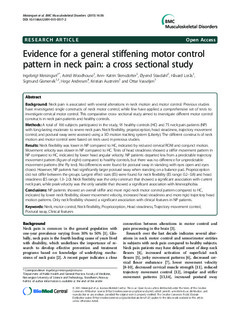| dc.contributor.author | Meisingset, Ingebrigt | |
| dc.contributor.author | Woodhouse, Astrid | |
| dc.contributor.author | Stensdotter, Ann-Katrin | |
| dc.contributor.author | Stavdahl, Øyvind | |
| dc.contributor.author | Lorås, Håvard W. | |
| dc.contributor.author | Gismervik, Sigmund Østgård | |
| dc.contributor.author | Andresen, Hege | |
| dc.contributor.author | Austreim, Kristian | |
| dc.contributor.author | Vasseljen, Ottar | |
| dc.date.accessioned | 2015-04-20T06:57:18Z | |
| dc.date.accessioned | 2015-11-19T14:15:15Z | |
| dc.date.available | 2015-04-20T06:57:18Z | |
| dc.date.available | 2015-11-19T14:15:15Z | |
| dc.date.issued | 2015 | |
| dc.identifier.citation | BMC Musculoskeletal Disorders 2015, 16(56) | nb_NO |
| dc.identifier.issn | 1471-2474 | |
| dc.identifier.uri | http://hdl.handle.net/11250/2364850 | |
| dc.description.abstract | Background: Neck pain is associated with several alterations in neck motion and motor control. Previous studies
have investigated single constructs of neck motor control, while few have applied a comprehensive set of tests to
investigate cervical motor control. This comparative cross- sectional study aimed to investigate different motor control
constructs in neck pain patients and healthy controls.
Methods: A total of 166 subjects participated in the study, 91 healthy controls (HC) and 75 neck pain patients (NP)
with long-lasting moderate to severe neck pain. Neck flexibility, proprioception, head steadiness, trajectory movement
control, and postural sway were assessed using a 3D motion tracking system (Liberty). The different constructs of neck
motion and motor control were based on tests used in previous studies.
Results: Neck flexibility was lower in NP compared to HC, indicated by reduced cervical ROM and conjunct motion.
Movement velocity was slower in NP compared to HC. Tests of head steadiness showed a stiffer movement pattern in
NP compared to HC, indicated by lower head angular velocity. NP patients departed less from a predictable trajectory
movement pattern (figure of eight) compared to healthy controls, but there was no difference for unpredictable
movement patterns (the Fly test). No differences were found for postural sway in standing with eyes open and eyes
closed. However, NP patients had significantly larger postural sway when standing on a balance pad. Proprioception
did not differ between the groups. Largest effect sizes (ES) were found for neck flexibility (ES range: 0.2- 0.8) and head
steadiness (ES range: 1.3- 2.0). Neck flexibility was the only construct that showed a significant association with current
neck pain, while peak velocity was the only variable that showed a significant association with kinesiophobia.
Conclusions: NP patients showed an overall stiffer and more rigid neck motor control pattern compared to HC,
indicated by lower neck flexibility, slower movement velocity, increased head steadiness and more rigid trajectory head
motion patterns. Only neck flexibility showed a significant association with clinical features in NP patients. | nb_NO |
| dc.language.iso | eng | nb_NO |
| dc.publisher | BioMed Central | nb_NO |
| dc.title | Evidence for a general stiffening motor control pattern in neck pain: A cross sectional study | nb_NO |
| dc.type | Journal article | nb_NO |
| dc.type | Peer reviewed | en_GB |
| dc.date.updated | 2015-04-20T06:57:18Z | |
| dc.source.volume | 16 | nb_NO |
| dc.source.journal | BMC Musculoskeletal Disorders | nb_NO |
| dc.source.issue | 56 | nb_NO |
| dc.identifier.doi | 10.1186/s12891-015-0517-2 | |
| dc.identifier.cristin | 1234221 | |
| dc.description.localcode | © 2015 Meisingset et al.; licensee BioMed Central. This is an Open Access article distributed under the terms of the Creative Commons Attribution License (http://creativecommons.org/licenses/by/4.0), which permits unrestricted use, distribution, and reproduction in any medium, provided the original work is properly credited. The Creative Commons Public Domain Dedication waiver (http://creativecommons.org/publicdomain/zero/1.0/) applies to the data made available in this article, unless otherwise stated. | nb_NO |
